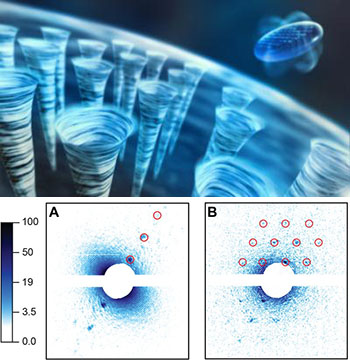
Top: Artist’s rendering of quantum vortices within superfluid nanodroplet [credit: SLAC National Accelerator Laboratory]. Bottom: X-ray diffraction images of doped nanodroplets [credit: Science 345, 906 (2014)].
At two degrees above absolute zero, liquid helium turns into a superfluid—an exotic state of matter in which all particles occupy a single quantum state, the liquid loses all internal viscosity, and it can perform feats such as climbing the sides of its container and seeping through molecule-sized holes. Scientists from the U.S.A., Germany and China have now zeroed in on helium superfluid at unprecedented detail, using ultrafast X-ray laser pulses to investigate the behavior of individual rotating superfluid nanodroplets. In so doing, the team has confirmed the presence of lattices of tiny quantum vortices—miniature tornadoes—within the droplets (Science, doi: 10.1126/science.1252395).
The finding culminates a decades-long quest. Scientists have long known that spinning a bucket of helium superfluid results in an array of quantized vortices, rather than the single vortex that would form from spinning a conventional liquid. Helium nanodroplets have been viewed as an ideal system for confirming that this superfluid behavior continues even at the smallest length scales. But, not surprisingly, it’s been tough to pin down the quantum mechanical behavior of a rapidly rotating droplet 100 to 1,000 nm across.
To get that insight, the team used the Linac Coherent Light Source (LCLS) free-electron X-ray laser at the Stanford Linear Accelerator Center (SLAC), U.S.A. The researchers sprayed a fine mist of liquid helium at 5 K into a vacuum, in which evaporative cooling caused the rotating droplets to become superfluid. The droplets were then doped with Xe atoms to provide a contrast source, and were hit with femtosecond pulses from the LCLS laser to create X-ray diffraction images. The Xe doping caused the quantum vortices to show up in the diffraction images in regular arrays.
Surprisingly, the team found that vortices are packed into the superfluid droplets 100,000 times the density seen in previous observations in spinning superfluids, and that the droplets themselves assumed shapes and rotation speeds unobserved in typical classical systems. SLAC’s Christoph Bostedt, a senior author on the paper, notes that the LCLS laser offers the potential for imaging other phenomena at previously unimagined scales. “Looking at the droplets,” he says, “gave us a beautiful glimpse into the quantum world.”
